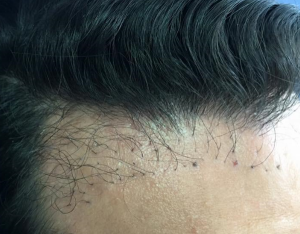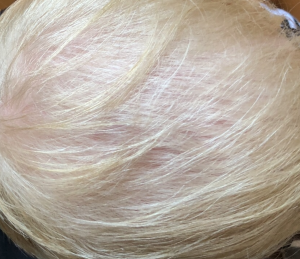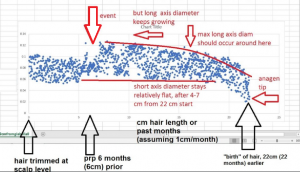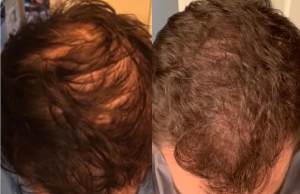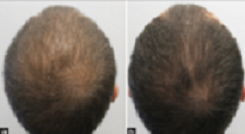This report was produced to sell a larger report to businesses interested in the hair loss business segment; nevertheless, I have shown the introductory part of this report because it outlines the various problems that contribute to hair loss. If you look at the post from today called “AS Hairs Grow Longer, they lose their thickness’ just below, you can imagine that this technology can actually tell you what would be the impact of taking supplements as it can track the value of the supplements on your hair as it grows. It would be much less expensive to have a way to measure the value of the supplement rather than take it blindly, spending a lot of money moving from one supplement to another and never knowing it your approach to treating your hair loss is working or not. https://www.transparencymarketresearch.com/hair-supplements-market.html
Can you imagine having to walk around with this presentation? This man has to wear a hat all of the time because his hairline presentation is terrible. If he is a professional man or does something that will not allow him to wear a hat for his living, he is just out-of-luck. Selecting a doctor is critical. If this man chose to purchase a hair transplant because it was inexpensive, he not only got robbed, but his deformity has damaged him in every-day life. The good news is that a hair transplant performed by a good doctor can fix it, but it will take from 4-8 months for the new hair transplants to grow out. While he is waiting, he is stuck with this look. Maybe a frontal wig will work, but this runs the risk of hair loss, so he has to make sure that he doesn’t walk into another pot-hole.
I wana go back to the gym. Im 3.5 month on fin with super awesome results. I talked with my friend about it he said when u start to lift ur body produce more Test. More Test mean more dht even on fin. So how do i go back to gym?
Don’t worry about DHT when you lift weights. Just work out. The finasteride will hopefully take care of your hair loss and your work-out will not raise your DHT levels, causing more hair loss.
The first picture is from Dr. Robert Haber’s magnified study of a hair scan of a single hair on one of Dr. Paul Cotterill’s female patients. It revealed that hair thickness and shape changes as the hair grows longer. The measurement scan below demonstrates the changes in this 21 cm long female single hair. Telogen is on the left (the end of the hair cycle) and the start of anagen on the right (where the new hair started to grow out from the scalp) showing how the shaft thickness and bulk builds as the hair starts growing and is widest at about 14-15 cm (about 15 months into the growth of the hair). It is clear that the hair thickness is greatest at the 14 -15 cm. length of the hair in this female patient. Dr. Haber told me that this was a normal female hair and she had no symptoms of a hair disorder. Clearly we need to understand the various conditions that this technology is capable of showing us as hairs are evaluated with regard to many different treatments.
In the second chart, a hair shaft thickness is shown over its length and the researchers, Dr. Michael Rabin and Dr. Robert Haber show the impact of an event that occurred in this particular patient’s hair (which had grown out for 22 months) but the event occurred 16 months into its growth cycle. The large arrow shows pointing down shows the timing of the event and it this case it was a PRP treatment 6 months ‘in time’ prior to the hair being cut off at its base at 22 months growth. Note this hair’s emergence from the scalp (beginning of anagen on the right) and the point where PRP was administered 16 months into its growth cycle (shown with large red arrow pointing down). It is easy to see the point where the event occurred, but interpreting it is another story. Is this a good result or a bad one? Was the hair ‘healthier’ after the PRP injection. The graph suggests it was less thick, but maybe it was a healthier hair?
This is exciting research to me because now after seeing it, I would want to know the impact of drugs like minoxidil on a normal terminal hair, (we now believe that there is no impact), the impact of finasteride on a miniaturizing hair (we now believe it increases the hair shaft thickness) and the growth of a single long hair with the patient on finasteride over time (does the benefit build slowly or is it a one time hit?). I just loved the creativity of these clinical researchers in producing a tool that can expand our knowledge in what is still, at times, a ‘Black Art’ for, the treatment of hair loss. . (Ref: http://neoangels.net/ishrsboston/hairscan.pdf)
From Reddit: So, I recently did a AMA on hair transplant, answered many questions and reacted to several people’s stories. I want to make something clear to everybody interested in or planning a HT. Fin is mandatory. Unless you just want to correct a shitty natural hairline and have solid reasons to believe you have no MPB in your genes, finasteride is a must do. I mean, use common sense here: if you have receded from NW1 to NWX over the years, what do you think is going to happen over the next decade? Hairloss doesn’t just stop at 30, 40 or whatever. At best it slows down.
So, if you do a transplant, especially at young age as I did, and don’t prevent further loss you are at risk of being in a situation aesthetically far worse than just balding. You are literally at risk of getting thinning or bald spots behind your transplanted area. And you cannot work you way around it:
You cannot do surgery after surgery over the years to maintain a decent set of hair. I mean, you can… but this is totally sub-optimal. First, because you only have a certain amount of donor hair. At top density with no diffuse you have in between 9 000 and 10 000 donor grafts. That’s a a lot. But if your crown balds and get diffuse thinning all over (which is usually the case of people considering HT) this easily drops down by 50 or 60%. You cannot fully compensate it with body hair. Unless you are a gorilla you don’t have tons of body hairs and their regrowth rate is way poorer than actual hair (around 60% for chest hair). Second: because you would have to wait to get significant balding/thinning to perform another operation (see point below) so you would look stupid in the meantime. And third: it would cost you a fortune, especially if you are planning several op because you would want a top doc that would take extra care of your donor zone.
You cannot merge grafted hair into the native hair to give you some leeway in case hairline recedes further back. This is not how it works. Unless you have a severe lack a density you cannot plug follicles between the original ones. There is too much risk of damaging the latter, so no decent surgeon will agree to do that.
That being said, I think HT are great. I also think it is okay to have it young and potentially have several transplants if required, but imo that can only be done once you max-out the preventive treatments for hairloss.
I suggest the use of finasteride in most men who do hair transplants with us under the age of 35. That is when the hair loss is most at risk, more the younger you are. A condition called Shock Loss occurs after a hair transplant in younger men who find that they often lose a great deal of their miniaturized hairs after the transplant, thereby accelerating the loss factor. Finasteride usually prevent this from happening. Many men who refuse to take finasteride, have never tried it and assume that they will get sexual side effects, which of course if they believe that, they will. I also noted more recently that sexual side effects are more commonly reported, but I am not sure if that is because of the power or the market focus on sexual side effects and Post Finasteride syndrome which frightens many potential users away, or it is real. We may never know but in the first 10+ years of prescribing thousands of young men this drug in my practice when the drug was introduced (prior to the introduction of PFS as a potential syndrome in 2011), the incidence of sexual side effects were consistent with the Merck study of between 2-4% in my practice from 1997-2010. That experience has been echoed by many of my colleagues.
I have prescribed it for a number of family members. It is a cooling head system that keeps the blood circulation to the scalp low during chemotherapy. On the three family member I recommended using it, none of them lost all of their hair although there was some thinning on one woman with Breast Cancer Chemo, but unlike many of her friends, she kept almost all of her hair for the entire chemotherapy period. (see: https://baldingblog.com/cold-cap-is-now-fda-cleared-to-hold-on-to-ones-hair-during-chemotherapy/ and see other links: https://baldingblog.com/?s=cold+cap ). Psychologically it is a Godsend for women with breast cancer not to be reminded of their disease every time they look in the mirror and see a bald woman.
I’m having an FUE procedure and i’ve seen plenty of people on youtube who are able to rock really short fades, pretty much bald fades after getting one of these procedures done (the haircut where you cut really low on the sides and back and gradually up it a little more), and I was wondering, in case I happen not to be able to pull it off, is it a possibility to get SMP (Scalp micropigmentation) over the punch holes (the FUE scars) so it blends in better?
Yes, SMP works wonders for FUE scars, when done properly. I wrote most of the medical literature on this ( https://scalpmicropigmentation.com/ ). Also read this extensive article: https://newhair.com/wp-content/uploads/2018/11/Journal-of-clinical-and-aesthetic-surgery-Article.pdf
Many people with early genetic hair loss get hairs that become miniaturized (less thick) over time, and this progresses until these hairs just fade away. The drug finasteride often slows, stops or reverses it.
It may be tied to your age and how long you have been bald. The longer you are bald (10-40 years) the less likely anything will grow. Is there any hair present?
Normally, I tell my patients that finasteride is a lifetime commitment. It takes about a year to see the benefits. Some see it earlier and a few see it later. Most people will find that it slows or stops the hair loss as opposed to reversing it. The younger you are when you start it, the better is the result so men who start it in their late teens probably see less long term balding than men who start it in their late 20s.
Page 7 of 7


